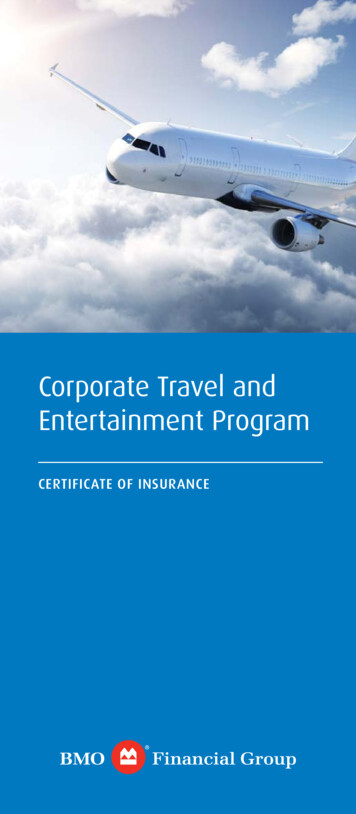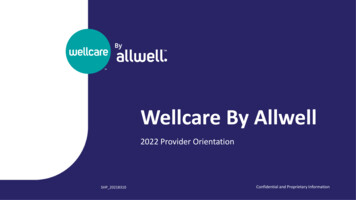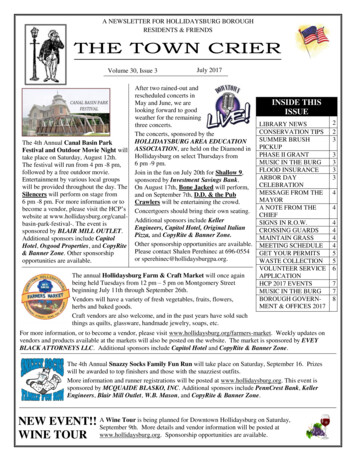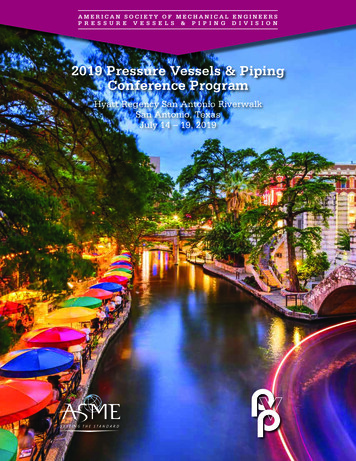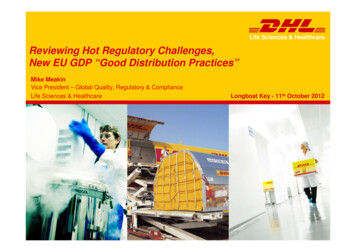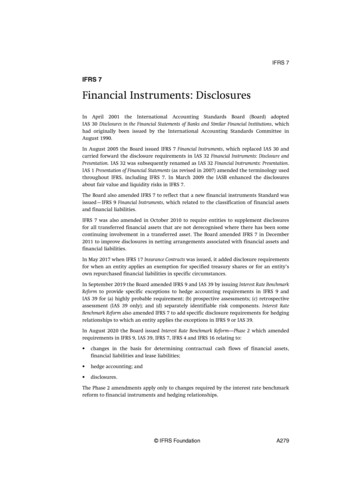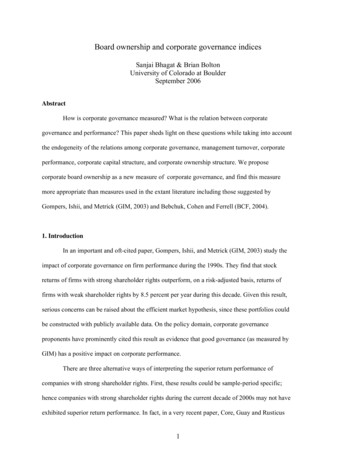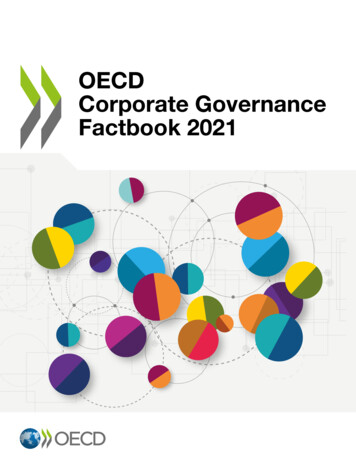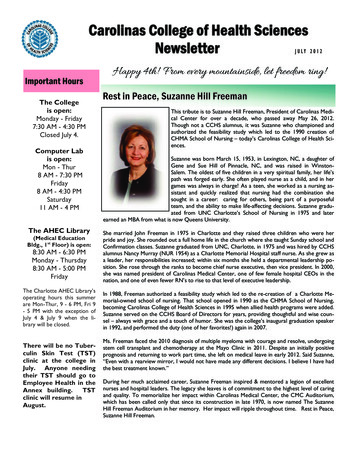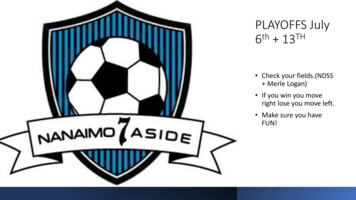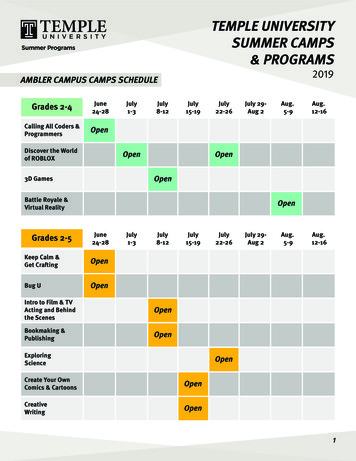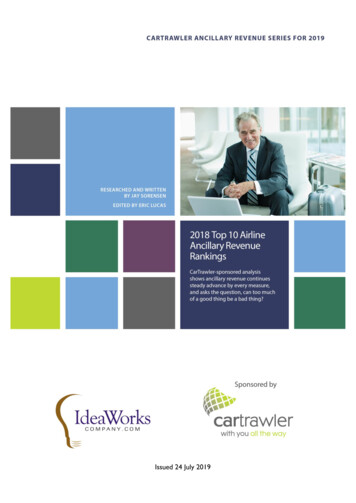
Transcription
Issued 24 July 2019
2018 Top 10 Airline Ancillary Revenue RankingsCarTrawler-sponsored analysis shows ancillary revenue continues steady advance by every measure,and asks the question, can too much of a good thing be a bad thing?ContentsIntroducing you to Nebeneinnahmen . 4Financial documents for top ancillary revenue producers were reviewed. 5Banks boost revenue for big carriers . 6Viva Aerobus is tops for ancillary as a percent of revenue . 8Ryanair is finding its baggage groove . 9The top ten list for ancillary revenue per passenger is a mix of airlines. 12Too much chocolate is not a good thing . 14The free distribution of this reportis made possible through the sponsorship of CarTrawler.CarTrawler is the world’s leading B2B travel technology platform. Its award-winningtechnology platform brings opportunities to life by creating global online marketplaces for its4,000 travel partners, 2,500 transport suppliers and one billion end customers. CarTrawleracts as a facilitator of relationships by connecting in real time to every significant transportsupplier globally. These include car rental, on-demand and pre-booked taxis, shared shuttleservices, bus and rail products. CarTrawler’s partners include over 100 airlines, 53 of whichare in the top 100 largest globally. CarTrawler is private equity-backed by BC Partners andInsight Venture Partners. For more information visit: https://www.cartrawler.comIssued by IdeaWorksCompany.com LLCShorewood, Wisconsin, USAwww.IdeaWorksCompany.com2018 Top 10 Ancillary Revenue RankingsIdeaWorksCompany.com LLC 2019Page 1
2018 Top 10 Ancillary Revenue RankingsIdeaWorksCompany.com LLC 2019Page 2
About Jay Sorensen, Writer of the ReportJay Sorensen’s research and reports have made him a leading authority on frequent flyerprograms and the ancillary revenue movement. He is a regular keynote speaker at theannual MEGA Event, spoke at IATA Passenger Services Symposiums in Abu Dhabi andSingapore, and has testified to the US Congress on ancillary revenue issues. His publishedworks are relied upon by airline executives throughoutthe world and include first-ever guides on the topics ofancillary revenue and loyalty marketing. He wasacknowledged by his peers when he received the AirlineIndustry Achievement Award at the MEGA Event in 2011.Mr. Sorensen is a veteran management professional with35 years experience in product, partnership, andmarketing development. As president of theIdeaWorksCompany consulting firm, he has enhanced thegeneration of airline revenue, started loyalty programsand co-branded credit cards, developed products in theservice sector, and helped start airlines and other travelJay, with son Aleksei and daughtercompanies. His career includes 13 years at MidwestAnnika, in North Cascades NationalPark in Washington.Airlines where he was responsible for marketing, sales,customer service, product development, operations,planning, financial analysis and budgeting. His favorite activities are hiking, exploring andcamping in US national parks with his family.About Eric Lucas, Editor of the ReportEric Lucas is an international travel, culture and natural historywriter and editor whose work appears in Michelin travel guides,Alaska Airlines Beyond Magazine, Westways and numerous otherpublications. Founding editor of Midwest Airlines Magazine, he isthe author of eight books, including the 2017 Michelin Alaskaguide. Eric has followed and written about the travel industry formore than 25 years. He lives on San Juan Island, Washington,where he grows organic garlic, apples, beans and hay; visit himonline at TrailNot4Sissies.com.Eric, at his favorite summer retreat, Steens Mountain, Oregon.Disclosure to Readers of this ReportIdeaWorksCompany makes every effort to ensure the quality of the information in thisreport. Before relying on the information, you should obtain any appropriate professionaladvice relevant to your particular circumstances. IdeaWorksCompany cannot guarantee,and assumes no legal liability or responsibility for, the accuracy, currency or completeness ofthe information. The views expressed in the report are the views of the author, and do notrepresent the official view of CarTrawler.2018 Top 10 Ancillary Revenue RankingsIdeaWorksCompany.com LLC 2019Page 3
2018 Top 10 Ancillary Revenue RankingsIntroducing you to Nebeneinnahmen“Nebeneinnahmen” is practically unpronounceable for many of us. But it has become aterm of endearment among German airline executives. It’s a German word for “ancillaryrevenue” and its increased usage demonstrates how it has remade the business models ofthe Lufthansa Group, the European airline industry, and the world.Back in 2009, Lufthansa disclosed inflight sales and travel sales commissions representingancillary revenue of one percent of revenue. Since then, Lufthansa’s ancillary world hasgrown to feature branded fares, seat-only fares within Europe and on transatlantic routes,and a collection of low cost carriers with 38 million passengers annually. The 2018disclosure by Carsten Spore, CEO of Lufthansa Group, caps all of these achievements ―ancillary revenue now equals 8 percent of revenue.1 This is a giant stride from 2009.Table 1: Top 10 Airlines – Total Ancillary Revenue (US dollars)Approximate Sources of RevenueAnnual Results – 2018FrequentA la CarteTravel RetailFlyer Program Such As Bags CommissionsAmerican 7,245,000,00077%23%United 5,802,000,00073%27%Delta 5,570,000,00074%26%Southwest 4,049,000,00084%16%Ryanair 2,801,536,938None100%Lufthansa Group 2,628,328,91232%*68%*Air France/KLM 2,579,438,796*21%*79%*easyJet 1,597,900,258None100%Spirit 1,493,108,0003%97%Air Canada 1,452,733,48839%61%2018 carrier results were based upon recent 12-month financial period disclosures.* IdeaWorksCompany estimate based upon updated past disclosure and other sources.Local currencies converted to US dollars at July 2018 rates of exchange.1Lufthansa Group 4th Quarter 2018 Investor Conference Call Transcript.2018 Top 10 Ancillary Revenue RankingsIdeaWorksCompany.com LLC 2019Page 4
This top ten list has become a billionaire’s club, which of course includes Lufthansa Groupand five other global players. By comparison, only three of the top ten reached a billiondollars of ancillary revenue in 2009. The group of ten represents ancillary revenue of 35.2billion, which is far above the 2007 result of 2.1 billion. Table 1 indicates the club includesmembers in Canada, France, Germany, Ireland, the Netherlands, the UK and US. Totalancillary revenue is one measure of ancillary revenue prowess. This report describes thevery best of ancillary results on the global stage, whether measured as total revenue, aspercent of revenue, or on a per passenger basis.Ancillary revenue and a la carte revenue are terms which can be easily confused. Ancillaryrevenue ― as defined below ― is not limited to fees for optional services. It also includesother ways in which passengers generate revenue for an airline. The revenue produced byfrequent flyer programs represents a very meaningful 55 percent of the total revenue listedin Table 1. But not for all carriers, as Ryanair and easyJet don’t yet offer loyalty benefits toconsumers. However, easyJet has announced plans to introduce a loyalty program, perhapsto generate co-branded revenue and attract more business travelers.Financial documents for top ancillary revenue producers were reviewedEvery year since 2007, IdeaWorksCompany searches for disclosures of financial resultswhich qualify as ancillary revenue for airlines all over the globe. Annual reports, investorpresentations, financial press releases, and quotes attributed to senior executives all qualifyas sources in the data collection process. Some airlines limit disclosure to a single item suchas duty-free sales or excess baggage fees, and this is normally associated with traditionalairlines. This report focuses on top performers, which provide robust description ofancillary revenue activities to catch the attention of the investment community.IdeaWorksCompany offers a definition of Ancillary RevenueRevenue beyond the sale of tickets that is generated by direct sales to passengers, orindirectly as a part of the travel experience.IdeaWorksCompany further defines ancillary revenue using these categories:1) a la carte features, 2) commission-based products, 3) frequent flyer activities,4) miscellaneous sources such as advertising, and5) the a la carte components associated with a fare or product bundle.From this list, total airline revenue and ridership data were collected to determine the topten airlines in overall ancillary revenue, as a percentage of company revenue, and on a perpassenger basis. In the process of collecting data for this report, we make note when detailsregarding the sources of ancillary revenue are identified. The collected data is reviewed andthis results in a few adjustments. For example, throughout the results in this report,revenue from cargo and change fees was subtracted from results when possible. The resultsfor the complete list of 70 disclosing airlines will be released in September 2019 as the12th annual CarTrawler Yearbook of Ancillary Revenue by IdeaWorksCompany.2018 Top 10 Ancillary Revenue RankingsIdeaWorksCompany.com LLC 2019Page 5
Banks boost revenue for big carriersIn Table 1, billion dollar ancillary revenue airlines are defined by two types: the world’slargest low cost carriers and global network airlines with mature co-branded credit cardportfolios. All sales generated from these activities qualify as ancillary revenue. The USmarket over the course of decades has become the land of revenue-rich card portfolioscourtesy of payments made by American Express, Barclays, Chase, and Citi banks to airlinefrequent flyer programs.Every time an airline cardholder makes a purchase, they accrue miles or points. These arepaid by the bank issuer of the card and the miles or points are then deposited to thefrequent flyer account of the cardholders. This is commerce on a grand scale. AmericanExpress SkyMiles cardholder spending increased from 45.4 billion in 2012 to 94.7 billionfor 2018.2 That’s more than double the entire revenue of 42.6 billion produced by DeltaAir Lines during 2018.3Table 2 contains a selected sample of 2018 results from our research. The results arestaggering, with the US carriers on the list representing revenue of more than 17.5 billion.Caution is advised, because not all the revenue is generated by co-branded credit cards.Frequent flyer programs have other sources too, such as miles sold direct to members, orpoints sold to hotel, car hire, and retail partners. However, 90 percent of this revenue istypically generated by relationships with bank partners.Table 2: Key Frequent Flyer Revenue Disclosures (US dollars)FFP Revenue perTotal Revenue (orNetwork Passenger Billings) From ProgramAirlineProgram NameQantas GroupFrequent Flyer 37.51 1,144,803,233AmericanAAdvantage 27.34 5,571,000,000UnitedMileagePlus 26.71 4,229,000,000SouthwestRapid Rewards 25.26 3,407,000,000DeltaSkyMiles 21.35 4,110,000,000HawaiianHawaiianMiles 18.50 219,000,000AeromexicoClub Premier 11.44 250,253,456Air CanadaAeroplan 11.22 571,366,391Virgin AustraliaVelocity 11.08 275,463,650AzulTudoAzul 10.95 253,132,391GOLSMILES 6.95 232,294,0932018 carrier results were based upon recent 12-month financial period disclosures.Local currencies converted to US dollars at July 2018 rates of exchange.Revenue or billing amounts benefitting the airline either as wholly/partially owned entity or as a partner.23American Express 2018 Annual Report.Delta Air Lines Form 10-K for the year ended 31 December 2018.2018 Top 10 Ancillary Revenue RankingsIdeaWorksCompany.com LLC 2019Page 6
Per passenger results can also be stunning. Qantas believes 35% of credit card spend inAustralia is on Qantas co-branded credit cards.4 That type of number should catch theattention of Australia’s secretary to the treasury. It’s easy to see why these are popularproducts for airlines operating in countries where consumers eagerly use credit andmerchant credit fees are lightly- or un-regulated. The latter is used by banks to fund thepurchase of miles and points from airlines.Air Canada, operating in an economy similar to the US, should be enjoying the 20 perpassenger revenues of its US airline brethren. But Aeroplan operated during 2018 as anindependently owned entity. The results listed in Table 2 represent sales of reward ticketsto the program operator Aimia. The airlinedoesn’t directly benefit from Aeroplan’s cobranded credit cards beyond this ticketrevenue. That’s one of the reasons why theairline chose to buy back the program fromAimia during 2019.Canadian banks are eager to continue therelationship with Air Canada and are payinghuge amounts of cash to sweeten the Aeroplandeal. TD Bank and the Canadian Imperial BankWestjet opportunity? Banks are paying millions toof Commerce have already made totalensure Air Canada and its frequent flyer programpayments of CAD 1.222 billion ( 913.4 million) members remain loyal to their credit cards as thelinked to card marketing relationships and theprogram changes ownership back to the airline.pre-purchase of Aeroplan miles.5 In addition,more payments tied to co-branded cards will be made by Visa and American Express. It’s awindfall of cash that greatly exceeds the CAD 497 million ( 371.5 million) the airline paid toAimia to buy the Aeroplan program back.The co-branded credit card business also appeals to smaller carriers. Here are someadditional findings from our ancillary revenue research: Allegiant in the US has recognized approximately 33 million in third party productrevenue from its co-brand credit card program since its introduction in 2016.6 Avianca in Colombia has a portfolio of 680,000 co-branded credit cards associatedwith its LifeMiles program. This cardholder base represents nearly 8 percent of its 8.9million program members.7 Volaris in Mexico has 235,000 co-branded cardholders, who generated revenue of 13.5 million for 2018.8 The airline does not have a frequent flyer program.4Qantas FY 2018 Results Presentation“Air Canada Completes Acquisition of Aeroplan Loyalty Business” press release dated 10 January 2019 atAirCanada.com.6Allegiant Travel Company Annual Report Form 10-K for the year ended 31 December 2018.7Avianca Holdings 2018 Annual Report.8Volaris Aviation Holding Company SEC Form 20-F for 2018.52018 Top 10 Ancillary Revenue RankingsIdeaWorksCompany.com LLC 2019Page 7
Viva Aerobus is tops for ancillary as a percent of revenueViva Aerobus jumped Spirit this year with a record 47.6% of revenue. Table 3 below liststhe top ten airlines for ancillary revenue as a percentage of total revenue. It’s a stablecollection of airlines that generally realize higher percentages year-over-year.The big change to the 2018 list is the disappearance of WOW air which posted a 28.5%result for 2017. The airline became insolvent in early 2019 and did not share its 2018results. Eight of the ten airlines achieved higher results when compared to 2017. Joiningthe top ten list for 2018 is AirAsia which had a dramatic increase from 17.3 percent to 29.0percent for 2018. This was largely due to an overall 11 percent increase and betterdisclosure of the group’s results.9Table 3: Top 10 Airlines – Ancillary Revenue as a % of Total RevenueAnnual Results – 2018Notable Ancillary Revenue Activities47.6%Viva AerobusThe airline improved the performance of its 3 branded fares.44.9%SpiritDynamic pricing for seat and bag fees was emphasized.42.8%FrontierFrequent flyer program was relaunched with new elite tiers.41.2%Allegiant41.1%Wizz AirFast track and lounge access added as mobile app functions.34.8%VoloteaInflight entertainment via mobile app for 1.99 added.32.3%VolarisDynamic pricing for seat and bag fees was emphasized.31.7%RyanairRyanair introduced priority boarding with carry-on bag benefit.31.1%Jet2.comAirline employs 600 customer helpers at resort locations.29.0%AirAsia GroupOnboard catering features more ASEAN-based SME vendors.Allegiant started offering a discount for roundtrip itineraries.2018 carrier results and activities based upon 12-month financial period disclosures.Ancillary revenue as a portion of total revenue appears to have reached a ceiling of 50percent. It’s easier for a non-global airline to achieve this high rate because the underlyingpassenger fares are lower for short- and medium-haul travel. Every year the ancillaryrevenue percentage for the bottom entry on the top ten list tends to nudge upward; twoyears ago it was 22 percent and last year it is 27.6 percent.The right side column in Table 3 lists notable 2018 activities that contributed to eachcarrier’s results. Dynamic pricing of a la carte services is referenced twice, for Spirit andVolaris. It’s a phrase that is unreliably defined in the airline industry and we believe technicalcapabilities are sometimes exaggerated. Volaris did reveal its method relies upon multiplevariables: season, route, customer attributes, time before purchase, type of market, time ofpurchase, and type of flight.10 Essentially, this applies revenue management techniques to thepricing of a la carte services. Look for more of this because it works so very well.9AirAsia 2018 Annual Report.Volaris Investor Day Presentation, 13 September 2017,102018 Top 10 Ancillary Revenue RankingsIdeaWorksCompany.com LLC 2019Page 8
For some airlines, such as JetBlue and Spirit, disclosures from financial filings provide arather complete picture of their ancillary revenue. The following pie charts feature redshading for baggage revenue, purple for loyalty, and blue for seating products.Low Cost Carrier ExamplesSpirit2018 Ancillary Revenue SourcesJetBlue2018 Ancillary Revenue SourcesBased upon company disclosuresBased upon company disclosuresEven More(seating andpriorityservices)25%LoyaltyProgram31%Other Activities8%HolidayPackages6%Passenger UseFee *36%Assigned Seats12%Baggage30%LoyaltyProgram3%Other Activities8%Baggage41%* Use fee (for online bookings) is considered to qualify as ancillary revenueonly because it can be avoided by buying tickets at the airport.Red dominates the two pie charts, which indicates the importance of revenue from baggagefees. Spirit generates a strong 21.15 per passenger from baggage fees.11 The carrier has anassertive baggage policy which includes fees for medium-sized carry-on bags. JetBluedisclosed average baggage revenue of 7.70 which demonstrates the results of a morerelaxed carry-on policy.12 Assigned seating has earned a strong 2nd or 3rd place in ancillaryrevenue pies, and this holds true for both LCCs and traditional airlines.Ryanair is finding its baggage grooveBut boy oh boy, it’s a complicated story. Let’s begin with a little history on the subject.Ryanair may have labeled 2018 as “annus horribilis,” borrowing a phrase used by QueenElizabeth to describe a horrible year experienced during her reign. Ryanair made more thanone attempt to create a bag policy balancing smooth airport operations, compliantcustomers, and attractive revenue. The need for change was identified by Ryanair in 2013,when its CEO Michael O’Leary confessed, “We should try to eliminate things that unnecessarilypiss people off.”13 Baggage was one of the problem areas.Ryanair finally implemented a policy in November 2018 that found the balance identifiedabove. The policy is best explained by an article from CNN Travel, “Under the new policy,non-priority boarding passengers are still allowed to bring a personal bag into the cabin freeof charge, but there will be a fee of 8 ( 9) to check in a small suitcase weighing up to 10kilograms (22 pounds). Passengers who purchase priority boarding will still be allowed tobring a personal bag and a small suitcase onto the plane.”14 Michael O’Leary’s desire toeliminate the expense of handling customer bags has always eluded him. But with thispolicy, he has lightened the load by encouraging travelers to carry their own . . . and in anorderly manner.11Spirit Airlines 2018 Form 10-K.JetBlue Investor Day 2018 Presentation dated 02 October 2018.13“Ryanair unveils new strategy: be nice to customers” article dated 20 September 2013 at Reuters.com.14“Ryanair changes hand luggage rules – again” article dated 01 November 2018 at CNN.com.122018 Top 10 Ancillary Revenue RankingsIdeaWorksCompany.com LLC 2019Page 9
I watched the “Priority & 2 Cabin Bags” policy in action during travels to Dublin earlier thisyear. I observed a number of flights, counted bags and passengers, and had impromptuconversations with ramp staff and gate agents on the concourse. Of course this beingDublin (the primary hub of Ryanair) passengers are well practiced in the carrier’s passengerprocesses. This may have influenced the overall result ― which was found to beexceptionally smooth and orderly. Gone were the public displays of agony that canaccompany the boarding of Ryanair flights.Operational staff had the following to say about the Priority & 2 Cabin Bags process: “It’sbetter than the policies we had during 2018 in terms of delays. Generally the boarding process issmooth, though families can cause issues. This occurs when a parent buys priority boarding forsome family members (likely the parents) and not for the kids. They are upset when the kids arenot allowed to board with the parents. Often gate staff will allow kids to board with the parents.Out of Dublin, we see shorter haul flights with about 10 to 15 bags in the hold, with the rest carriedby passengers into the cabin. For longer haul flights, 60 checked bags is a good average quantity.The priority boarding is capped at 80 passengers.”Observations and conversations from the Dublin airport visit are reflected in the Table 4data and calculations. Ryanair does use variable pricing for a la carte services, such aspriority boarding. Assumptions were made on the distribution of Priority & 2 Cabin Bagspricing for the Birmingham and Alicante flights; this information was not gathered fromairport staff. Based upon a review of the booking path for the two city pairs, Ryanairappears to offer Priority & 2 Cabin Bags at 6, 9, and 12 per passenger. Prices increaseas a flight books up with passengers.Table 4: Comparing Typical Ryanair Bag ActivityCity pairDublin - BirminghamDublin – AlicanteFlight durationAbout 1 hourAbout 3 hoursAircraft capacity189 economy seats189 economy seatsPriority & 2 Cabin Bags sales 30 passengers @ 6 180 30 passengers @ 9 270(includes 10 kg cabin bag)50 passengers @ 12 600 50 passengers @ 12 600Bags checked at counter15 bags @ 15 22560 bags @ 25 1,500Bag exceptions handledat the gate with fee applied2 bags @ 25 each 503 bags @ 25 each 75Total ancillary revenue 1,055 ( 1,184) 2,445 ( 2,744)(assume basic 20 kg bag)Baggage activity is based upon observations and discussions with operations staff at Dublin Airport during early 2019.Assumes standard fares, with “Priority & 2 Cabin Bags” prices increasing as a flight fills.This policy is a stroke of genius because it combines two things passengers adore: earlyboarding and the certainty of stowing a roll-on bag. Ryanair obviously did the math andfound its overhead bins comfortably fill up with the carry-on bags of the first 80 passengers.It’s an intuitive offer for consumers. Plus non-priority passengers spend many minutes atthe gate observing the benefit of the Priority & 2 Cabin Bags option. Then these nonpriority passengers board afterwards and are checked by gate agents for non-compliantcarry-on bags. These passengers are pulled aside and their bag is checked for a 25 fee.2018 Top 10 Ancillary Revenue RankingsIdeaWorksCompany.com LLC 2019Page 10
Ryanair appears to be using Priority & 2 Cabins Bags as a revenue platform upon which totest new services and refine how baggage is merchandised. The carrier’s booking path iscomplex and uses every opportunity (and screen space) to sell baggage services and assignedseating. At times the distinction between early boarding, baggage, and seating becomes ablur of pop-up boxes and interruptions. It all has the feeling of being unstructured andexperimental ― which probably reflects the involvement of the Ryanair Labs group.It’s true, it’s true! Ryanair’s former small bag limit was 35 x 20 x 20 cm. And yes, Priority is the most popularproduct, and yes it does sell out as indicated by the shaded imaging and text in the center.After selecting a flight, the consumer chooses from three branded fares: Standard, Plus, andFlexi Plus. Standard does not include a checked bag, while Plus includes a checked 20 kgbag, but the higher priced Flexi Plus does not. Seat assignment is promoted next courtesyof a pop-up display in the website booking path. Baggage choices are offered later on; thebaggage retail presentation varies according to the fare purchased.Standard fare passengers can consider a new “10 kg Check-in Bag & 1 Small Bag” whichremoves the priority boarding benefit and restricts travelers to the smaller carry-on. Theadded sales almost don’t matter, as the carrier has found a strong revenue base with thePriority & 2 Cabin Bags offer. We imagine this service is the defacto choice for mostconsumers and sells out for almost every flight. It’s the no-hassle way to fly Ryanair anddoesn’t cost more than 12. We anticipate the top end of this fee will increase.Finding the operational, customer service, and revenue balance is difficult for airlines. WizzAir continued in 2018 to see declining revenue from years of baggage policy changes. ForFY 2019 it was 5.30 per passenger, which represents a decline from 8.10 for FY 2018,and 10.10 for FY 2017.15 Fortunately for investors, the airline has increased ancillaryrevenue from other areas. As of November 2018, Wizz Air has a baggage policy similar toRyanair. The first carry-on bag is free for all passengers; buying the Wizz Priority optionadds a medium-size carry-on bag. Wizz Air management says the new policy has createdmore efficient operations and improved on-time performance. During a recent investor call,Iain Wetherall, Wizz Air CFO, said Priority was generating average revenue of more than 1 per passenger.16 On an annual basis, that would be more than 34 million.1516Wizz Air FY 2019 and FY 2018 Results Presentations.Wizz Air FY 2019 3rd Quarter Investor Call.2018 Top 10 Ancillary Revenue RankingsIdeaWorksCompany.com LLC 2019Page 11
The top ten list for ancillary revenue per passenger is a mix of airlinesThe top performing airlines in this list were once dominated by low cost carriers, buttraditional airlines are now more numerous (Table 5 below). The definition of ancillaryrevenue includes the results produced by a carrier’s frequent flyer program and provides asubstantial per-passenger revenue boost for global airlines such as Qantas and United.Table 5: Top 10 Airlines – Ancillary Revenue per PassengerAnnual Results – 2018(in US dollars)AncillarySource2008 Comparison(in US dollars and % increase above 2008) 50.94SpiritVarious 18.61174% 50.01AllegiantVarious 26.6688% 47.62*FrontierVarious 3.701187% 43.91Jet2.comVarious 19.04131% 41.15Qantas AirwaysFFP 15.83160% 36.64UnitedVarious 22.8660% 35.56AmericanVarious 19.6781% 34.74Virgin AustraliaVariousNot available 34.28AirAsia XVariousNot available 32.70HawaiianVariousNot available2018 and 2008 carrier results were based upon 12-month financial period disclosures.* IdeaWorksCompany estimate based upon past disclosure and updated for current report.Local currencies converted to US dollars at July 2018 and July 2008 rates of exchange.Hawaiian appears on this top ten list for the first time. The ancillary revenue identified forthe carrier includes the sale of frequent flyer miles, baggage fees, and its Extra Comfortseating. The service provides more leg room, fast track screening (7 airports), earlyboarding, at-seat power, and on select flights, expanded IFE choices, and an amenity kit.Traditional airlines, like Hawaiian, have quickly moved to expand revenue opportunitiesassociated with seating. Extra leg room seats, premium economy, and the basic element ofassigned seating have become surprisingly routine for this airline category.The arrival of basic economy fares has openedthe door for traditional airlines to experimentwith an ever-expanding list of a la carte fees.These are indeed interesting times withunexpected outcomes. It’s true, these faresallow carriers like Delta, British Airways, andAir France to compete with low cost carrierslike Frontier, Norwegian, and easyJet. Onecan forgive consumers who are confused bythe dizzying array of choices, and alsoconfused by how this relates to the inherentBritish Airways with “Seats for two” borrowed an ideafrom KLM which is called “Seats in a row of 2.”promise of a global airline brand.Image: From BA.com booking path2018 Top 10 Ancillary Revenue RankingsIdeaWorksCompany.com LLC 2019Page 12
We took the opportunity to further examine seat-related fees. The highly competitive NewYork – London market is a good choice, notably because low cost Norwegian has asignificant presence. In this unscientific exercise, the lowest priced departure was chosenand we looked at the assigned seating options available to consumers booking a basiceconomy fare. The comparison in Table 6 simply displays fees for assigned seating anddoesn’t consider how the price of fares migh
camping in US national parks with his family. About Eric Lucas, Editor of the Report Eric Lucas is an international travel, culture and natural history writer and editor whose work appears in Michelin travel guides, Alaska Airlines Beyond Magazine, Westways and numerous other publications. Founding editor of Midwest Airlines Magazine, he is
